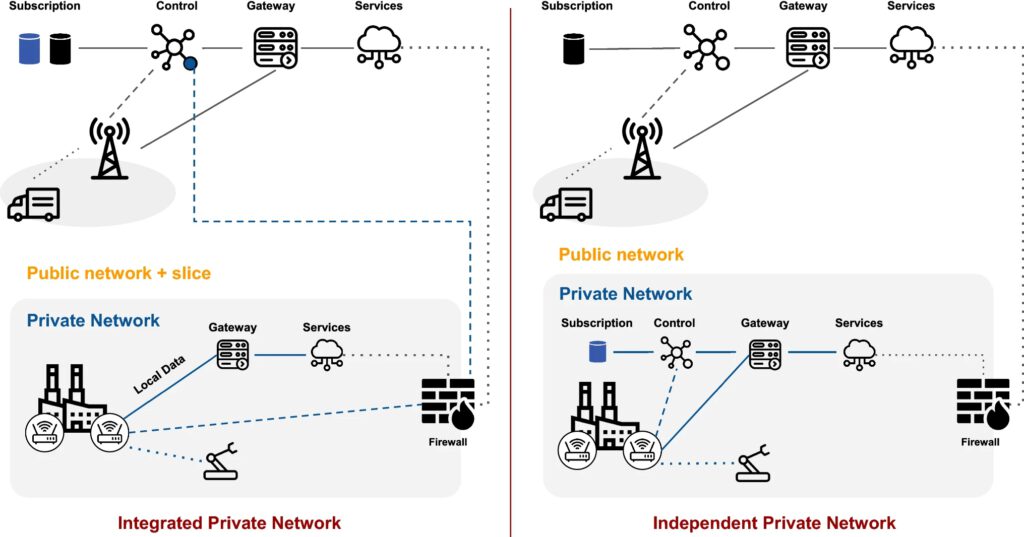As the automotive industry accelerates toward a future of smarter, safer, and more efficient transport, private 5G networks are emerging as a game-changing enabler of connected mobility. These dedicated cellular networks offer ultra-low latency, high-speed data exchange, and secure communication — all critical elements for supporting the next generation of connected vehicles.
What Are Private 5G Networks?
Private 5G networks are localized cellular systems built for specific enterprises or environments. Unlike public 5G, which is shared across many users, private networks provide dedicated bandwidth, ensuring predictable and reliable performance.
Network Architecture and Integration
In traditional public 5G networks, most devices rely on Public Land Mobile Network (PLMN) IDs for connectivity, which requires authorization from Mobile Network Operators (MNOs). This dependency introduces additional steps and potential vulnerabilities. In contrast, Private 5G networks operate independently using Standalone Non-Public Network (SNPN) IDs, which allow direct, secure connections without MNO involvement. This leads to faster data flow, simplified device management, and improved security.
To bridge the gap between private and public 5G, the industry also leverages Public Network Integrated Non-Public Networks (PNI-NPNs). These hybrid models use MNO infrastructure to grant access to private network slices via Dedicated Data Networks (DNNs) managed behind 3GPP user plane gateways. By separating the User Plane Function (UPF), Session Management Function (SMF), and related IP data paths, this architecture maintains a distinct flow for private traffic while still sharing some backbone infrastructure. To protect these systems, 3GPP introduced Closed Access Groups (CAGs) in Release 16, allowing only authenticated devices to join.
Alternatively, network slicing offers another solution. MNOs can dedicate slices within their 5G networks exclusively for private use, assigning specific instances of components like gNodeB User Plane (gNB-CU-UP), UPF, and SMF. These slices act as isolated virtual networks within the same physical infrastructure, optimizing performance and security while managing Quality of Service (QoS) based on application demands.

Why Private 5G Networks Matter in Automotive Connectivity
Private 5G enables real-time communication across vehicles, infrastructure, and cloud systems, forming the digital backbone for connected mobility. Key benefits include:
- Ultra-Low Latency: Critical for autonomous driving, real-time vehicle diagnostics, and instant data processing.
- High Security: Enables OEMs to control their network environment, minimizing the risk of cyber threats.
- Scalability: Supports a wide range of applications — from smart traffic management to connected factory operations.
Applications in Automotive and Mobility Environments
- Smart Manufacturing:
Private 5G in automotive factories enables real-time monitoring, robotics, and automation with minimal downtime. - Vehicle Testing & R&D:
OEMs can create controlled environments with private 5G for vehicle simulations, data testing, and performance evaluations. - Fleet Connectivity:
Logistics providers benefit from reliable and secure fleet tracking and predictive maintenance powered by real-time analytics. - Urban Mobility Infrastructure:
Integration with smart traffic systems and citywide vehicle networks improves coordination, safety, and flow.
Private 5G: Complementing Edge Computing and AI
Private 5G networks work hand-in-hand with edge computing and AI-based analytics, enabling decisions to be made closer to the vehicle — improving reaction times and reducing cloud dependency. This synergy unlocks capabilities such as:
- Real-time hazard detection
- Dynamic traffic rerouting
- Instantaneous in-car updates and diagnostics
Conclusion: A Private Path to a Connected Future
As mobility becomes more connected and autonomous, private 5G networks stand out as the infrastructure cornerstone. With Horizon Connect, we are committed to building a secure, agile, and intelligent ecosystem that powers the next era of mobility.


